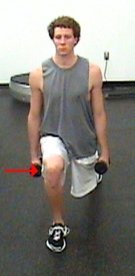Ankle Dorsiflexion:
As we have discussed, there is a ripple effect up the entire kinetic chain. A dorsiflexion restriction is very evident in lunging patterns. A lunge is essentially a similar movement pattern as a squat, but it places a much larger load on the lead leg, due it’s single leg stance position. It necessitates knee flexion, glute firing, core stabilization, ankle dorsiflexion and a whole lot of stabilizing muscles. It is one of the easiest ways to recognize a weak core and glute.
Performing a good, clean lunge is imperitive for the following reasons:
- Lunges teach the body to work in a functional manner on a single leg. A great deal of movements in speed and power sports are performed on a single leg. If an athlete is not trained in that manner, both performance and injury risk are affected.
- Lunges expose core and glute weakness in training. A weak glute will allow the knee to move towards the body’s midline and into valgus. This is the most common position for an athlete to tear their ACL or develop patella femoral pain. If you allow them to train in this position, you are feeding the body’s nervous system information that this is a normal position, exposing them to even greater risk of injury. Much of the same is true of a weak core and it’s tendency to allow an athlete’s trunk to flex forward excessively.
- Because of the demands placed on the single leg, a lunge is a great way to help eliminate asymmetries with one side of the body being weaker than the other.
The Path of Least Resistance
Poor dorsiflexion will affect lunges in several ways. As we have said, it will limit the athlete’s ability to effectively lunge cleanly in a sound biomechanically correct manner, so an athlete will find another way to get the job done. Remember that the body will aways find the path of least resistance. Meaning, the body will always sacrifice quality of motion for quantity of motion. So, if you ask an athlete to lunge lower or perform many of them (quantity of motion), it will find the easiest path to get lower or perform extra reps, even if it is a poor quality lunge. Poor dorsiflexion can affect a lunge in several ways, but there is one compensation pattern that affects it the most. When an athlete with a dorsiflexion restriction lowers themselves down, they usually start a chain reaction beginning with foot pronation. As the foot flattens out excessively to gain extra motion, it will cause an internal rotation of the lower leg. This rotation then causes the knee to move into valgus, which is just the position we are trying to avoid. Some athletes with a dorsiflexion restriction will lift their front heel off the ground as well, although that is not seen all that often because it will significantly decreases the stability of the athlete while performing the lunge exercise.
Poor dorsiflexion can affect a lunge in several ways, but there is one compensation pattern that affects it the most. When an athlete with a dorsiflexion restriction lowers themselves down, they usually start a chain reaction beginning with foot pronation. As the foot flattens out excessively to gain extra motion, it will cause an internal rotation of the lower leg. This rotation then causes the knee to move into valgus, which is just the position we are trying to avoid. Some athletes with a dorsiflexion restriction will lift their front heel off the ground as well, although that is not seen all that often because it will significantly decreases the stability of the athlete while performing the lunge exercise.
To learn more about fixing the dorsiflexion restriction, click here…
Looking for more help? Schedule a consultation today!
Back to Ankle DorsiflexionBack to Injury Rehabilitation
Back to Home


Leave a Reply